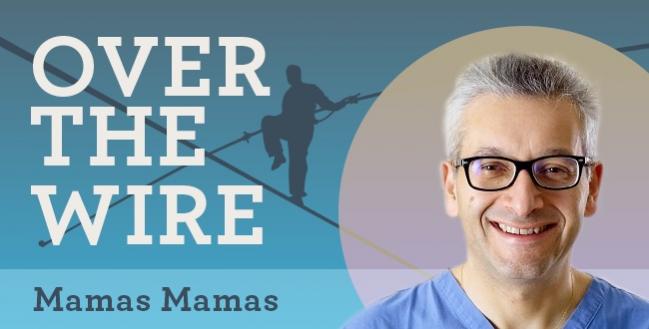Talking Women’s Heart Health Until We’re Red in the Face
Every February, social media blushes scarlet with pictures and selfies of physicians Going Red for Women. Is it doing any good?

Every February, social media blushes scarlet with pictures and selfies of physicians “Going Red for Women.” For weeks, proud, diverse teams use the anniversary to honor long-departed family members or offer personal stories of how cardiovascular disease has impacted their lives or hewn their life goals, pushing them to develop research programs and clinical services dedicated to cardiovascular disease in women. Some posts detail the personal anguish that many have faced of not being believed, of having their symptoms minimized, or of being met with blank stares in clinic rooms and emergency departments—only to have a cataclysmic heart attack or stroke validate the awful truth that they were right all along, giving fresh power to their voices. These pictures are a living mirror, capturing journeys and life experiences. As poet Maya Angelou put it: “There is no greater agony than bearing an untold story inside you.”
Everyone knows many of these dire statistics, that cardiovascular disease is the leading cause of death amongst women globally, accounting for one-third of all deaths. Myocardial infarction claims the lives of 3.3 million women every year, with another 3.2 million women dying from stroke and the remaining 2.1 million women succumbing to other cardiovascular diseases. Despite these sobering facts, only half of all women recognize that cardiovascular disease is the principal cause of death in women, with most viewing cancer as their main health concern.
The American Heart Association’s Go Red for Women initiative has helped to raise awareness among physicians and patient groups alike. And yet, as I sat as a panelist and speaker in the Canadian Women’s Heart Health Summit earlier this month, my heart sank. In sessions around primary prevention, heart failure, acute coronary syndrome, structural heart disease, and cardiac surgery the messages were as consistent as they were clear: despite all the photos, papers, and publicity, women remain less likely than men to receive optimal treatments, and their outcomes are worse. Not a month goes by without another publication repeating the same messages from a different cohort, in a different healthcare system, for yet another form of cardiovascular disease. So how effective are such initiatives and meetings when these disparities do not seem to change?
The Greek philosopher Heraclitus once said, “No man ever steps in the same river twice, for it’s not the same river and he’s not the same man.” Having participated in many of these sessions over several years, I began to think how they have changed me both as a physician and researcher, and how I had contributed to changing these rivers in my own way. The dedicated sessions focused around heart disease in women that I’ve attended or participated in over the years have made me consider how, as a researcher, I could measure whether such inequalities existed in the healthcare systems I serve, using data that I have access to. These meetings and initiatives have inspired me to support and work with female physicians and researchers that I’ve met at conferences or through social media trying to address such inequalities, and to form new research alliances to extend and amplify this work. I thought about how these women’s selfies posted to celebrate Go Red for Women, smiling up at me from my smartphone, reminded me of the work that we have undertaken together and the research networks that we have formed.
We recently ran a story on TCTMD (with an all-too-familiar headline) on an analysis of over 1.2 million patients presented at the STS meeting, showing that women are less likely to receive complete revascularization, a LIMA to the LAD, or arterial grafts as part of their CABG procedure. Whilst such a report is interesting, it serves mainly to validate previous work in this space and, a few years ago, may have resulted in a few conference hall discussions. Nevertheless, I tweeted about it, and within a few hours of my post, physicians from North and South America, Europe, the Middle East, and Southeast Asia had joined the conversation online, discussing the reasons for inequalities in care and making suggestions for how we can improve our practices. One surgeon from Switzerland tweeted that the discussion had stayed with him throughout a CABG that he performed shortly thereafter on a woman who had a very-small-diameter LIMA, a technically challenging procedure, but with our discussions fresh in his mind he had persisted to ensure she received a LIMA. Were it not for our discussions, perhaps she would have received a vein graft instead.
It dawned on me then that only by having these conversations can we have a meaningful impact on women’s heart health. It may not be that the data are necessarily novel or different, but rather it is the conversations about the data that can make a difference. Initiatives such as Go Red for Women, or meetings like the Canadian Women’s Heart Health Summit, or stories like the one on TCTMD keep the discussion alive and in doing so, impact how we practice, inspire our work, and increase awareness of CV health amongst the 50% of women who still believe CV disease is not relevant to them.
My appointment to TCTMD as senior clinical editor is a significant responsibility that I do not take lightly: it allows me the real ability to encourage a diversity of voices around such important themes, as well to amplify the dialogue around the studies covered. My aim is to drive wider conversations around cardiovascular disease in its many facets, and in the vastly different groups of patients affected. As the novelist John Green put it: “In the best conversations, you don't even remember what you talked about, only how it felt.” I believe these discussions can bring new light to data that don’t always get center stage, and if these conversations don't make us feel strongly enough to inspire changes in our practice to reduce inequalities in care and outcomes, then we have failed.
Over the Wire is a first-person blog and does not reflect the editorial position of TCTMD.
Mamas Mamas, BMBCh, DPhil, is the Senior Clinical Editor at TCTMD. He is the Clinical Director for the Centre for…
Read Full Bio




Comments